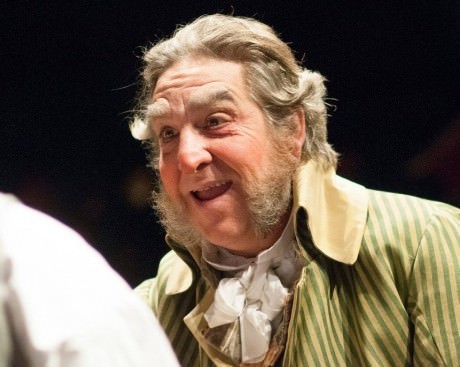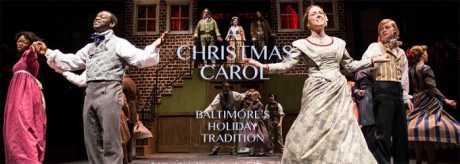Have yourselves a very merry Christmas – go see this timeless classic with a Charm City twist. Bring the family to this show! Kids of all ages will love it.
Instead of watching the Mister Magoo cartoon version for the gazillionth time, put down the damn remote and head to the historic Mercantile Trust Building in downtown Charm City.

This production of A Christmas Carol has an appeal that spans ages, race, and religious affiliations. Charles Dickens’ message of redemption, with a Baltimore twist, warms the heart and celebrates the spirit of the holiday season in a way no Black Friday shopping spree can compare.
Ian Gallanar adroitly holds myriad roles in this production. In addition to being the theater company’s founding artistic director, he adapted the Charles Dicken’s classic to give it a little “Old Bay” flavor, and was its director with Scott Alan Small. Gallanar was also the show’s sound director. Molly Moores directed the amazing youngsters in the show.
Instead of pence and pounds, the audience gets a thoroughly Bal’more version of cents an common cents, a few digs at then-President Van Buren (Martin Van Ruin) and the brand new “liberal” newspaper, the Baltimore Sun, plus a verbal tour of the surrounding neighborhoods, like Mt. Vernon, where Scrooge resided.
Yet, on opening night, Gallanar was not there. Instead he was at the Players Club in Manhattan’s Gramercy Park, not far from the statue of the club’s founder Edwin Booth (brother of John Wilkes Booth), being inducted into the National Theatre Conference, composed of American Theatre leaders.
Kudos to Ian!
In adapting this beloved British classic, Gallanar made ample use of the history of Baltimore and of the company’s “home” the imposing, historic beaux arts Mercantile Trust Building built in 1886 to house a bank (and in the 1990s, the Redwood Trust nightclub), in the core of the city’s old financial district. It was one of the rare buildings that survived the Great Baltimore Fire of 1904.
The show is set in the era of Dicken’s time, 1834, but in downtown Baltimore. Ebnezer Scrooge’s firm, Scrooge & Marley, a counting house, has the same address as the old Mercantile Trust – 7 German Street (It was renamed South Calvert decades later).
Opening night, the two upper mezzanine levels were brimming with youngsters, many of them members of the local Boys & Girls Clubs. Unlike most productions, where there is a crisply defined start time and intermission period, this family-friendly version was more fluid.
As the audience entered, they could opt to find their seats – or buy a drink from one of two bars, and bring it with them to their seats. Performers were already onstage singing Christmas carols and songs. The audience was encouraged to get up and move around during the show. If the ghosts of Past, Present, or Future scared a child, they could go into the vault – a real steel vault – and watch the show from there on monitors.
During the intermission, instead of disappearing backstage, the performers mingled with the audience or joined the onstage caroling. An additional 18 songs were seamlessly threaded through the show.
The thrust stage, surrounded on three sides by the audience, featured a three-story set resembling old brick townhomes, linked by bridges and a dual staircase. The stage, itself, served as the Scrooge & Marley office, Scrooge’s bedroom, the Cratchit family home and other locations. The actors often entered and egressed through the audience.
Nor was there a wall between the players and audience. The characters and musicians made frequent eye-contact with folks on all three levels, or would turn to direct a comment or scene to one person in the seats.

The huge cast played multiple roles. Some portrayed several characters, others nimbly moved from a dramatic scene to singing, or playing a guitar, accordion, violin, ukulele, piano or percussion instrument. Thanks to choreographer Nellie K. Glover, they danced as one might imagine wassail-infused adults in the 1830s strutted or staggered through the minuet. Nick Delaney was the music director and music arranger, a musician and vocalist.
The costumes designed by Kristina Lambdin – seemingly hundreds of them – were evocative of the era without inhibiting the actors’ movements. The garments were well researched, crafted and finished, a credit to seamstresses Karen Murphy and Kaitlyn Howland. Haley Raines Young designed the thespians period wigs, hair and makeup. The top hats and millinery were perfect.
Nowhere in the credits is there a mention for the creator of spooky fog effects. The stuff billowed out at unexpected times – and unexpected places – in a myriad colors, often with menacing tendrils that reached into the audience. The stuff scared the kids more than the Ghost of Christmas Yet To Come – a skeletal, spooky Vince Eisenson.
The five lead characters Ebenezer Scrooge (Gregory Burgess), his woefully underpaid clerk Bob Cratchit Patrick Kilpatrick), Scrooge’s nephew Fred (James Jager), George William Brown (Obinna Nwachukwu), Robert Cary Long (E. Martin Ealy), and the Ghost of Jacob Marley (Scott Alan Small) were excellent, as were narrators Tim R. Bintrim (Mr. Fezziwig) Kecia A. Campbell (Older Bell), and A.J. Calbert (Young Scooge), and Gareth Swing (Tiny Tim).

Burgess’ with his deep voice that could instantly pivot to a falsetto squeal, evoked the equally Scrooge-ish Redd Fox with his comedic timing, rascally persona and bullying tirades at innocent schoolchildren singing holiday songs. His Scrooge is an angry, lonely, tightwad with a sad backstory and a sadder future if he doesn’t change his ways.
Patrick Kilpatrick’s Bob Cratchit makes the audience pull its collective sweaters more tightly around themselves. His Cratchit, shivering in a freezing cold office, is all too real So, too, is his pain at not being able to fully support his wife and children, especially his son Tiny Tim, who is disabled.
Scott Alan Small’s first appearance as a disembodied head on a door knocker (How’d they do that?) and then, erupting from a chest at the foot of the bed was enough to give anyone nightmares. He and Burgess interacted like long-separated twins, who shared a love of money, wealth and penurious lifesyles. Only Marley wants his old partner Scrooge to change his ways.
The plot is as classic, well-known and beloved as a chestnut roasting on a open fire. But, we still won’t give it away except to say this terrific production is something to share this holiday season with family and friends.
The entire cast and crew should take a bow – and a bough of holly.
Running Time: Approximately two hours and 15 minutes, with a 20-minute intermission.
A Christmas Carol plays through December 23, 2015 at Chesapeake Shakespeare Company – 7 South Calvert Street, in Baltimore, MD. For tickets, call the box office at (410) 244-8570, or purchase them online.
Parking at a covered garage less than two blocks away, with a special voucher obtained at the theater during the show, is only $5.

Note: Five year-old Hal Kilpatrick makes his debut tonight as Tiny Tim. His mom, Teresa Castracane, is the excellent photographer for this production, and his Dad, Patrick Kilpatrick is playing Bob Cratchit. A new family tradition begins.





